|
|
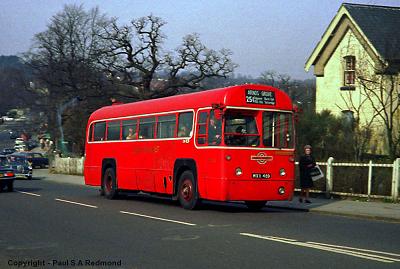 Red
RF routes Red
RF routes
Route 251
Page last updated 27 December
2018
A remarkable route across north London that has covered the
same roads for over 85 years. RF operation moved in 1963 from
Muswell Hill garage, also home to the 210
and 212, to Edgware, which had just
replaced the last TDs in service with RFs on the 240A.
RF512, later to become
famous at Kingston, pulls up the hill to Totteridge & Whetstone
Station.
Photo
© Paul Redmond
Dates of RF
operation
6 May 53 (weekends, but see below), 1 May 57
(daily, but see below) to 29 Jan 77.
Converted to OMO 27 Jan 65
(total 23 years 9 months, of
which 11 years 9 months crew operation).
Destinations
ARNOS GROVE and BURNT OAK Edgware Road (6 May 53 to 6
Sep 68)
ARNOS GROVE and STANMORE STATION (7 Sep 68 to 29 Jan
77)
RF Garages
MH Muswell Hill to 26 Feb
63
EW Edgware from 27 Feb 63
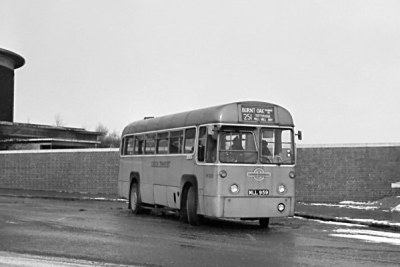 Reason for single-deck operation Reason for single-deck operation
In its initial form, from Edmonton to Whetstone, there was a
low bridge at Silver Street, Edmonton. The extension to Burnt
Oak in 1933 took the route under the low rail bridge at Mill Hill
Broadway that also affected the 240, so
single-decking remained after the Edmonton section was
withdrawn. By 1966 when the road under the bridge was
lowered, the route had been converted to OMO, then only available
on single-deckers, so single-decking continued, as it does to this
day. The route is second only to the 227 in longevity of single-deck operation in the
Central Area.
Muswell Hill's RF322, one of the second batch
delivered new for the 210, commences
the U-turn off the Arnos Grove stand across Bowes Road. Photo © Geoff
Morant, Mike Morant collection
Route history
Route 551 was introduced on (or about) 4 Jul 25 between
Whetstone Griffin Inn and Edmonton Aerator's
Works, via Arnos Grove (which was then largely undeveloped and
rural) and the newly-opened North Circular Road. The Griffin
at Whetstone had long been a staging post on the Great North Road
and the 551 provided a connection with General route 84 and
Overground route 284 as well as the trams.
The route was introduced by Redburn's Motor Services, joined a
month later by Biss Brothers and at the start of 1926 by Uneedus
and HM Merry. All used single-deck Dennises, except Uneedus
who ran Guys. Single-deckers were required because of a low
rail bridge at Silver Street, Edmonton.
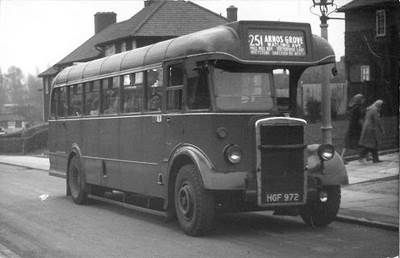 TD14 at the Barnfield Road terminus at Burnt
Oak in November 1951, its Weymann body less than 6 years old but
already looking antiquated. No doubt the crew are having
tea in a cafe on the Edgware Road; their passengers look as if
they're getting anxious. Photo © Alan Cross
On 27 Jan 26, the General joined in, with three K-class
single-deckers worked from Tottenham garage (AR). Later in
1926, more Dennises joined in, from Sear Brothers, Silver Star and
Prince, whilst original operator Redburn's was absorbed by the
General. The other independents were in turn absorbed by the
General, either directly or through amalgamation into Public (see
236), which was itself taken over by
General in 1929. The last was Prince, whose single chocolate
and cream Lion probably carried on working short workings until
takeover on on 5 Dec 34.
In 1928, the entire operation moved into Public's new Enfield
(E) garage at Ponders End, and a year later the route was extended
a small distance westwards to Totteridge Barnet
Lane. December 1930 saw a small extension in Edmonton
along Angel Road, from Sparklet's Works (as the Aerator's Works had
become in 1926) to Cook's Ferry.
In 1931, the Dennises were replaced at E by 16 new single-deck
LTL Scooters. With most routes now operated by pneumatics
tyred buses, for which the speed limit was 20mph rather than 12mph,
a programme of speeding up routes using the same frequencies
resulted in more efficient use of buses. This was applied to
the 551 in November 1932, when E's allocation reduced by one
LTL.
Doorless RF478 at Arnos
Grove on 28 August 1961, when the route ran only to Burnt Oak and
was operated by Muswell Hill.
August 1933, just after the creation of London
Transport, saw the extension of the route much further
west via Mill Hill to Burnt Oak, and E was joined by Palmers Green
garage (AD), working the Whetstone to Edmonton section numbered
551A. As well as buses from E, several LTLs were
transferred to AD from Hounslow (AV), where they were replaced on
the 105 (later 201) by Ts.
On 16 May 34 the Arnos Grove to Edmonton section was replaced by
an extension of the double-deck 604 (later 34) to Whetstone,
leaving the Burnt Oak to Arnos Grove route in a form that was to
remain unchanged for 30 years. The whole operation moved from
E to AD on the same day (with AD also gaining the substantial extra
allocation on the 604). The Scooters released from the route
went to Hornchurch and Kingston, and to Elmers End and
Nunhead where they replaced single-deck Ss. But
although time-expired, these lasted another two years on the
230 at Harrow Weald, 235 at Croydon and 242 at Enfield.
In common with other routes numbered under the Bassom system, short workings were given
letter suffixes, which in the case of the 551 reached
551 E. This was a weekday working between
Whetstone and Arnos Grove, introduced in February 1934 and
double-decked (with LTs) in May of that year. October
1934 saw the new route numbering
system introduced and the 551 series became the 251, with an
allocation of 6 LTLs from AD. The double-deck workings were
replaced by increased running on the 34 in April 1935.
Crew-operated RF325
working MH1 also stands abandoned at the Barnfield Road stand at
Burnt Oak.
Photo © JH Aston, Peter
Gomm collection
The 1930s saw the development of much of the rural area that
the route traversed. Arnos Grove Station on the Piccadilly
Line opened in 1932. Mill Hill Broadway had developed
around the 1867 Mill Hill Station, but was surrounded by open
country until the 1930s. The route shared the low
bridge at Mill Hill with the 240 (later
split, with the 240A becoming
an RF route), requiring the continued use of single-deck buses
until the road was lowered in 1966.
AD continued
to operate the Scooters, aided by one T operated by
Edgware (EW) garage on shorts between Burnt Oak and Mill Hill for
one year from 1936. In the summer of 1939,
the whole route move from AD to EW, then in 1941, to increase
the allocation, to Muswell Hill (MH), with EW retaining some
Sundays workings until the following year. From 1936 to 1941,
then again from 1946, Sundays saw an increased allocation
reflecting the rural nature of the route. This peaked in 1947
and 1948 at 15 buses (against a weekday requirement of 9), with the
balance changing by the mid-50s when Sunday allocation fell behind
that on weekdays.
Muswell Hill had received its first TDs - all 31 of the
Weymann-bodied batch of these Leyland single-deckers - between
December 1946 and June 1947, primarily for the 212. A further nine, from the Mann Egerton
batch, were received in spring 1949 to replace the LTLs on the
251. The Sunday service still required 11 buses, so two LTLs
remained allocated on that day for the summer season (the
244 and part of the 210 were still LTL-operated). Contributor
John Hillman recalls the single-deck LTs on the 251 that boiled up
going up Highwood Hill and had to fill with water using a
watering can left at the top.
Edgware-based OMO RF445
stands at the same terminus in 1972. Compare the scene eleven
years earlier, above.
Photo Ian Armstrong
collection
Having received the first TDs in 1946, MH also received the first
red RFs in 1952. After introduction on the 210 (October 1952)
and 212 (February 1953), RFs were also used on the 251 on Saturdays
and winter Sundays from 1953 to May 1955. Whilst the
official weekend allocation only included RFs from 6 May 53,
photographic evidence confirms that they worked before that date
(the photo in question being one of
RF486 at Arnos Grove bearing TD-style blinds and used as a
postcard postmarked 4 May 53). Weekend
use reflects the reduced requirement on the 212 at weekends
and the 210 on winter Sundays; full details of the official
allocations are at the foot of the page, it is not clear why these
excluded RFs from May 1955 to October 1956, as RFs continued
to be available at MH at weekends.
Six red RFs had been converted to Green Lines at the
start of 1956, accompanied by renumbering of several batches
of buses. Through the insistence of the unions that the
central fleet be maintained at 225, six green RFs eventually went
to Sidcup on 1 Dec 56. In addition, a dozen green buses were
loaned to Sidcup to cover the first RF overhaul programme, started
in September 1956.
In December 1956, Muswell Hill received an influx of
red RFs, taking its allocation from 36 to 43. These
buses were available, directly by transfer or indirectly by the
allocation of newly overhauled buses, due to the green RFs at
Sidcup; six TDs went to Kingston where they replaced the green
15T13s. There were now enough RFs to enable the
conversion of the 251 daily (although the formal allocation didn't
catch up until the summer schedules in May 1957, it is likely that
conversion from TD operation was largely complete on 1 Dec
56). In May 1957, including the 251, 209 RFs were scheduled
for service (Monday to Friday) in the Central Area, close to the
213 at the end of 1953 when Loughton's 254 received the 'extras' released through
schedule changes. The RF allocation seems to have been a little ambitious, as
the winter 1957 allocation schedule admits the requirement for a
single TD on Monday to Friday. This was TD127, the last TD at
Muswell Hill.
BL9 in its final livery in
the late 1980s. It waits at Arnos Grove to depart for
Stanmore Station.
Photo ©
Paul Davis, Ian Armstrong collection
On 27 February 1963, the route moved unchanged (back) to
Edgware garage as part of a reorganisation involving Enfield and
Potters Bar garages; Muswell Hill gained the balance of the
134. Edgware had only four months earlier replaced the last
TDs by RFs on its long-standing route 240A. October of that year saw
the extension of some Sunday journeys (only) to Edgware,
replacing garage workings from Burnt Oak.
In his memories of working at Edgware, Alan Bond mentions an unadvertised short
working from Arnos Grove Station to the Standard Telephone works up
at Brunswick Park and back again. The works were off Oakleigh
Road South, just before the bridge over the railway. Was this
the only RF-operated unadvertised works journey? Please
let us know. OMO conversion of the 251, still with RFs, came in January
1965, in the second phase along with the 237. The 240 A remained
crew-operated and lost its RFs in favour of RTs (as a
Sunday-only route) in 1966. In September 1968, the 251 was
extended on weekdays to Stanmore via Edgware, to cover part of
trolleybus replacement route 245. On Sundays the route
operated only as far as Edgware Station. Another period of stability followed until the RFs were
finally replaced by BLs on 30 Jan 77, the same day as another very
long running RF route, the 234A, and leaving RFs
running only at Hounslow and Kingston.
BLs lasted until 1990, the last route to operate the class
and replaced by a variety of midi-buses starting with
Starriders. From 1990, the route was amended to double-run
via Edgware Station, before being cut back to Edgware in
1993. The route still runs, now operated by London
Sovereign from Edgware and still covering the final version of the
General's route 551.
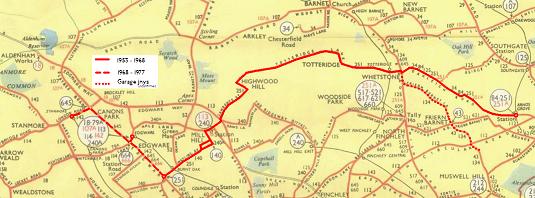
Based on 1955 map © London Transport
RF route in detail, with timing points
ARNOS GROVE STATION, Bowes Road, Oakleigh Road South,
Oakleigh Road
Woodman, Oakleigh Road North, Whetstone Griffin, Totteridge
Lane, Totteridge War
Memorial, Totteridge Lane, Totteridge Common,
Highwood Hill, Highwood Hill
Marsh Lane, Highwood Hill, Lawrence Street, Mill
Hill Broadway, Mill Hill Station,
LMR (later Mill Hill
Broadway Station), Bunns Lane, Woodcroft Avenue,
Watling Avenue, Barnfield Road (return via Edgware Road), BURNT OAK
Edgware Road (to 14 Jul 67).
ARNOS GROVE STATION, Bowes Road, Oakleigh Road South,
Oakleigh Road
Woodman, Oakleigh Road North, Whetstone Griffin, Totteridge
Lane, Totteridge War
Memorial, Totteridge Lane, Totteridge Common,
Highwood Hill, Highwood Hill
Marsh Lane, Highwood Hill, Lawrence Street, Mill
Hill Broadway, Mill Hill Station,
LMR (later Mill Hill
Broadway Station), Bunns Lane, Lyndhurst Avenue,
Eversfield Gardens, Woodcroft Avenue (return direct
from Woodcroft Avenue to Bunns Lane), Watling Avenue,
Barnfield Road (return via Edgware Road), BURNT OAK Edgware
Road (15 Jul 67 to 6 Sep 68).
ARNOS GROVE STATION, Bowes Road, Oakleigh Road South,
Oakleigh Road
Woodman, Oakleigh Road North, Whetstone Griffin, Totteridge
Lane, Totteridge War
Memorial, Totteridge Lane, Totteridge
Common, Highwood Hill, Highwood Hill
Rising Sun, Highwood Hill, Lawrence Street, Mill
Hill Broadway, Mill Hill Broadway
Station, Bunns Lane, Lyndhurst Avenue, Eversfield
Gardens, Woodcroft Avenue (return direct from Woodcroft Avenue
to Bunns Lane), Watling Avenue, Burnt Oak Bald Faced Stag (Sunday
journeys terminate Burnt Oak
Barnfield Road), Edgware Road, High Street Edgware,
EDGWARE STATION (Sun) or Edgware
High Street, Edgware Road, London Road, STANMORE
STATION (Mon-Sat) (from 7 Sep 68).
Burnt Oak terminal working: from Watling
Avenue into Barnfield Road, layover on left, forward to Edgware
Road, Watling Avenue.
When operating from Muswell Hill garage, buses entered and left
service at Whetstone, suggesting that garage journeys ran via
Friern Barnet Lane and Colney Hatch Lane. From 9 Oct 63 (8
months after operation moved to Edgware), some Sunday garage
journeys were extended from BURNT OAK Edgware Road to
operate from EDGWARE ABC Cinema via Station Road, Edgware
High Street, Edgware Road. Otherwise until 1968, buses
entered and left service at Burnt Oak or Highwood
Hill.
Frequency
| Year |
Mon-Fri |
Sat |
Sun |
| 1936 |
15 mins |
15 mins |
10-15 mins |
| 1938 |
15 mins |
15 mins |
15 mins |
| 1941 |
10-15 mins |
10-15 mins |
10-15 mins |
| 1946 |
10 mins |
10 mins |
7½-10 mins |
| 1951 |
10-12 mins |
10 mins |
10-12 mins |
| 1953 |
10-12 mins |
10-13 mins |
8-10 mins |
| 1959 |
10-15 mins |
12-15 mins |
20 mins |
| 1964 |
10-15 mins |
18-20 mins |
30 mins |
| 1969 |
8-13 mins |
17-20 mins |
60 mins * |
| 1971 |
8-13 mins |
20 mins |
60 mins * |
| 1976 |
20 mins |
22-23 mins |
40 mins |
* more frequent Burnt Oak - Arnos Grove
The journey time from Arnos Grove to Burnt Oak was about 40
minutes, to Stanmore 48-54 minutes. The July 1967
timetable is here.
Faretable
To view the faretable for May 1965, including garage journeys,
click here.
RF allocation (but see notes)
MH had no additional allocation of new RFs for the 251; as
noted above, the route used RFs spare from the 210 and 212 at
weekends until 1957.
PVR 1952 (Oct): Mon-Fri 9 TD, Sat 9 TD,
Sun 9 TD
PVR 1953 (May): Mon-Fri 9 TD, Sat 6 RF + 3 TD,
Sun 11 TD
PVR 1953 (Oct): Mon-Fri 9 TD, Sat 8 RF + 1 TD,
Sun 5 RF + 4 TD
PVR 1954 (May): Mon-Fri 9 TD, Sat 5 RF + 4 TD,
Sun 11 TD
PVR 1954 (Oct): Mon-Fri 9 TD, Sat 5 RF + 4 TD,
Sun 9 TD
PVR 1955 (May): Mon-Fri 9 TD, Sat 9 TD, Sun 9
TD
PVR 1955 (Oct): Mon-Fri 9 TD, Sat 9 TD, Sun 7 TD
PVR 1956 (May): Mon-Fri 9 TD, Sat 9 TD, Sun 9
TD
PVR 1956 (Oct): Mon-Fri 9 TD, Sat 6 RF + 3 TD,
Sun 5 RF + 1 TD
PVR 1957 (May): Mon-Fri 9 RF, Sat 9 RF, Sun 8
RF
PVR 1957 (Oct): Mon-Fri 8 RF + 1 TD, Sat 9 RF, Sun 6 RF
PVR 1958 (Apr): Mon-Fri 9, Sat 7, Sun 7, now
all RF
PVR 1958 (Oct): Mon-Fri 9, Sat 7, Sun 5
PVR 1963 (May): Mon-Fri 9, Sat 6, Sun 5
PVR 1963 (Oct): Mon-Fri 9, Sat 5, Sun 4
PVR 1963 (Nov): Mon-Fri 9, Sat 7, Sun 4
PVR 1965 (Jan, OMO): Mon-Fri 11, Sat 9, Sun 5
PVR 1965 (Sep): Mon-Fri 9, Sat 7, Sun 5
PVR 1965 (Oct): Mon-Fri 11, Sat 9, Sun 5
PVR 1966 (Dec): Mon-Fri 11, Sat 7, Sun 4
PVR 1968 (Sep, extended): Mon-Fri 14, Sat 7, Sun 4
PVR 1969 (Jul): Mon-Fri 14, Sat 6, Sun 4
PVR 1971 (Apr): Mon-Fri 14, Sat 5, Sun 4
PVR 1972 (Dec): Mon-Fri 12, Sat 5, Sun 4
Memories
Alan Bond writes of his
time at Edgware - see the 240A page - which included work on
the 251.
David Mitchell lived in
Oakleigh Road North, Whetstone, until his family emigrated to
Australia in September 1956. He recalls:
'I regularly used the 251 route to school at Mill Hill and
latterly to Stanmore. I can certainly recall RFs running on
the 251 before we left. Although they certainly had not
completely replaced the TDs by September 1956, as suggested
they probably did so on Saturdays and Sundays. My memory
indicates they began running some 18-24 months before the above
date and I can remember being a most excited 12/13 year-old when
they did!'
Ian Rivett, on his website,
recalls the early days of RFs on the 251 from MH, running
to the now defunct Barnfield Road terminus in Burnt Oak. 'MH 5, I
think was the first to arrive in the morning followed by MH 6-9,
then MH 1-4. The first four used to go towards Arnos Grove and the
rest towards Burnt Oak. This was just on conversion after the TDs
were withdrawn. MH 1, 4 & 7 used to depart to the garage after
the morning peak only to return out of sequence in the afternoon.
MH 1 followed MH 2, 4 after 5 and 7 after 8.
Although some sources list the Saturday 251 allocation as being
mixed TD/RF from May 53 to May 57, I don't recall seeing a mixed
allocation on Saturdays, only TDs.'
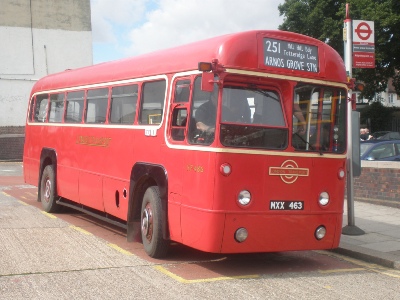 David Streatfield's blog
40 years on the buses includes the following
note: David Streatfield's blog
40 years on the buses includes the following
note:
'I had to learn [all of the Edgware routes] with the
exception of the 251 which was a ‘one man’ operated route,
(political correctness had not crept into the English language in
1967). As the 251 was driven only by the elite of the garage, the
most senior drivers, there was very little chance of junior drivers
ever working that route so route learning was considered a waste of
time. All the routes at Edgware were operated by RT and RTL double
deck buses except the 251 which was operated by the RF type single
deck vehicle.'
Re-creation
RF486 returns to Arnos Grove after 57 years. Photo © Martyn
Littell
|
|